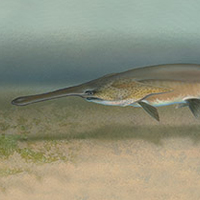Paddlefish
Scientific name: Polyodon spathula

Cover photo credit: Timothy Knepp, US Fish and Wildlife Service
Status
Extirpated
“ Extirpated ” means the species lives somewhere in the world, and at one time lived in the wild in Ontario, but no longer lives in the wild in Ontario.
Date added to the Species at Risk in Ontario List
The Paddlefish was already listed as extirpated when the Endangered Species Act took effect in 2008.
Read the most recent assessment report (PDF)
What it looks like
The Paddlefish is a thick, robust fish with a long, paddle-like snout called a rostrum, which may take up to half the length of the body. Like its close relative the Lake sturgeon, its skin is smooth and without scales. This primitive species is one of the largest freshwater fishes in North America. Paddlefish can reach two metres or more in length and weigh more than 70 kilograms. Males reach sexual maturity after seven years, whereas females mature later at nine to 12 years.
Where it lives
Paddlefish live in slow-moving sections of large rivers and lakes, but they migrate to large, fast flowing rivers with gravel bottoms to spawn. Females can lay more than 150,000 eggs, but they do not spawn every year.
Where it’s been found in Ontario
The Paddlefish was likely never common in the Canadian portion of its range. There are only three verified reports of the species in Ontario waters – in Lake Huron (near Sarnia), the Spanish River and the Nipigon River, with the last specimen captured in Ontario in 1917.
The current range of the Paddlefish is the Mississippi River system from Montana to Louisiana, and some smaller rivers draining into the Gulf of Mexico.
Why it disappeared from Ontario
It is not known what exactly led to its demise in Ontario, or the Great Lakes.
The Paddlefish has declined across its entire range, due largely to loss of spawning habitat and over-fishing. Like the sturgeon, the Paddlefish is valued for its roe which is processed into caviar, and a small commercial fishery still exists in some states. Because this fish matures so slowly, over-harvesting can quickly deplete a population. Other threats across the species range include dam construction which has blocked access to spawning sites, dredging of channels and pollution.
Action we are taking
Extirpated species and their habitat are protected if the species are again found in Ontario.
Help make sure we don’t lose more endangered species in Ontario
Report a sighting
The Ministry of Natural Resources and Forestry tracks species at risk such as the Paddlefish; you can use a handy online form to report your sightings to the Natural Heritage Information Centre; photographs with specific locations or mapping coordinates are always helpful.
Volunteer
Volunteer with a local nature club or provincial park to participate in surveys or stewardship work focused on species at risk.
Be a good steward
Private land owners have an important role to play in species recovery; you may be eligible for stewardship programs that support the protection and recovery of species at risk and their habitats; for more information visit: ontario.ca/speciesatrisk
Report illegal activity
Report any illegal activity related to plants and wildlife to
Quick facts
- Paddlefish have no teeth and eat by filtering zooplankton out of the water; they swim with their mouths open, filtering the water through gill arches in the mouth; the gill arches have filaments on them called gill rakers that sieve the zooplankton organisms from the water.
- The Paddlefish is one of the most prehistoric fishes in Ontario, with fossil records dating back 70 to 75 million years ago.
- The Paddlefish (and sturgeons) are closely related to sharks as they have a skeleton that is mostly cartilage rather than bone.